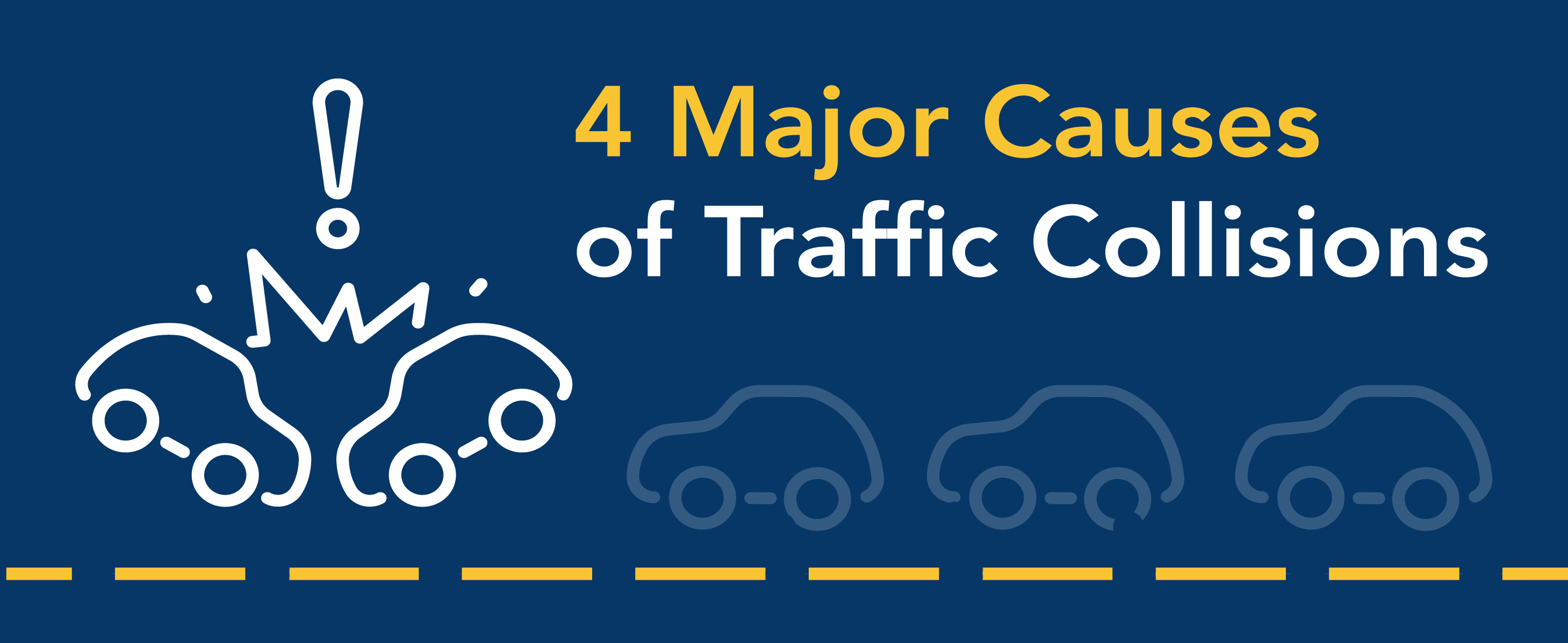Number One Cause Of Collisions

According to the National Highway Traffic Prophylactic Administration "National Motor Vehicle Crash Causation Survey," over 97% of all motor vehicle crashes are caused by driver error. This is why motor vehicle crashes are not called "accidents" by law enforcement and commuter teaching professionals. Accidents are simply that, unintentional, unforseen mistakes. They happen all the time. Nosotros accidentally drop our cell phone, or accidentally walk into a drinking glass door. When a vehicle blows through an intersection and collides with some other vehicle or pedestrian — that isn't an accident, just a preventable traffic collision.
What is Considered a Traffic Collision?
A traffic collision, also referred to every bit a motor vehicle collision, is when a vehicle makes contact with some other vehicle, pedestrian, animal or stationary object. Even with good visibility and in the best of atmospheric condition, intersections are a high-run a risk area for collisions.
4 Major Causes of Traffic Collisions
Distracted Driving – Ane of the biggest and most common reasons for traffic collisions involves distracted driving and cell phone utilize.
Impaired Driving – Driving under the influence of listen altering substances (ie: alcohol, prescription drugs, cannabis etc.)
Speeding – For every 10 miles per hour over 50 mph, the take chances of death in a traffic collision doubles.
Poor Driving Conditions – Driving at night, in snowfall, rain and other less than ideal conditions can increment your chances of existence involved in a traffic standoff.
How to Avoid a Traffic Standoff
Fifty-fifty for experienced drivers, intersections are among the near hazardous locations and are the site of many traffic collisions. It may audio unproblematic, but the sooner you size-up an intersection and identify the potential hazards, the more than likely you are to avoid a traffic collision. As you enter an intersection, browse the entire block for potential problems. Your browse should help determine which lane to select. Besides, check the traffic light. If it is light-green when you enter the block, anticipate it will alter by the time you reach the intersection. Take your foot off the accelerator and cover the brake. Doing so will let you to stop smoothly should the light change.
Don't assume that other drivers volition be able to finish when they are approaching an intersection. A driver might blow right through. As well, if another driver is turning at the intersection, he/she may not be able to make the turn successfully and could veer into you. In light traffic conditions, effort to time your approach so you lot exercise not achieve the intersection at the verbal time as another vehicle.
Exercise caution when operating your vehicle at high speeds on a large roadway. Generally, high-speed roadways, when compared to other roadways, have a lower frequency of collisions; notwithstanding, when a standoff does occur, it is often more severe considering of the combination of speed and impact.
When you lot plan to drive in areas that yous are not familiar with, be certain to know your exit number ahead of time. Knowing the leave number before your leave will give you plenty of time to position your vehicle properly. If you inadvertently miss your exit, do not back-up. This may cause a collision with other exiting traffic. Instead, wait for traffic to clear. Then go to the next exit to double dorsum.
Practice Scanning Alee
Stay alert of the potential dangers and scan ahead to avoid rear-terminate collisions. The driver should steer and focus their attention high, and so as to view the road as whole and not merely a few feet alee.
Identify, Predict, Determine, and Execute (IPDE): This is the footstep-by-step process behind the p rinciples of defensive driving and complexities of visual perception in traffic – information technology could very well save your life and those of your passengers.
Steps of the IPDE process are:
I — Place — Locate potential hazards inside the driving scene
P — Predict — Judge where the possible points of conflict may occur
D — Decide — Make up one's mind what action to accept, when, and where to have it
E — Execute — Act by maneuvering the car to avoid conflicts
IPDE can assist y'all avoid collisions. Have a moment to think through the IPDE process and how you should apply information technology while driving. In the event of a collision, use extreme caution and seek emergency medical assistance.
For more than information on our course offerings or if you have any questions, contact Top Driver .
Number One Cause Of Collisions,
Source: https://www.topdriver.com/education-blog/4-major-causes-of-traffic-collisions/
Posted by: campbellwathre.blogspot.com


0 Response to "Number One Cause Of Collisions"
Post a Comment